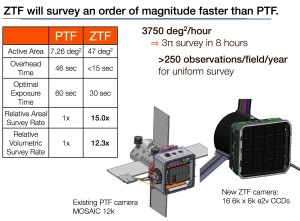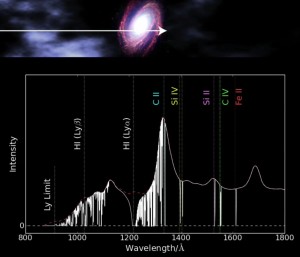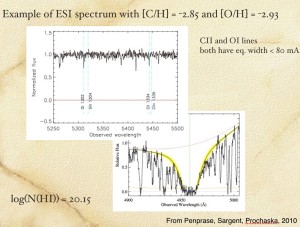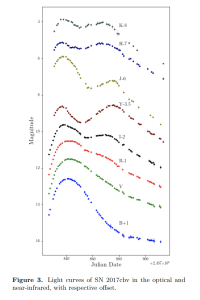Astrophysics from Asteroids to Quasars!
My research encompasses a wide variety of observational astrophysics. It can be summarized as the observational astrophysics of “everything from asteroids to quasars” – which is both spanning a wide range of alphabet and astronomical distance scales! The breadth of the research is a response to opportunities that arise for students to engage in cutting-edge astrophysics using telescopes available to me. The telescopes include the observatories at Pomona College, which I have developed over 20 years into a network of telescopes ranging from 14″ Celestron Paramount systems to our 1-meter telescope at Table Mountain Observatory. Phil Choi, my colleague at Pomona has taken over the last of these resources, and added a very advanced capability – an advanced adaptive optics instrument known as KAPAO. In addition to those resources, I have access to a wide range of telescopes from my Caltech and Carnegie collaborations. Over the years this has led to a number of great opportunities for research at Las Campanas Observatories in Chile, and the Keck telescope in Hawaii, as well as official partnerships with those institutions resulting in summer undergraduate research opportunities (such as the Carnegie-Claremont Astrophysics program), and major instrument development (such as the Robo-AO and KAPAO projects, which linked Pomona and Caltech). Since coming to Soka University of America, we built a new system known as the Nieves Observatory at Soka University, which is a research-grade Planewave telescope system with 0.3-meter aperture, suitable for followup observations of supernovae, novae, asteroids and other objects. The website for that new system is available here: https://sites.soka.edu/SUO/.


When I was based at Yale-NUS College in Singapore, my astrophysics research efforts focused on developing a local network of observational astronomers, who can respond quickly to transients and who can coordinate in solar system observations. To this end, I convened a research conference at Yale-NUS College which included astronomers from NARIT (Thailand), Lulin Observatory (Taiwan), SNU (Korea), as well as from the Malaysian national observatory, a Turkish research institute, and Pomona College in California. We were joined at that meeting by Glenn Orton from JPL and Chris Go from the Philippines, and they described opportunities for ground-based astronomers to support the NASA Juno mission during August of 2016 and beyond as the spacecraft encountered the planet. I am working closely with Glenn Orton and his JPL team and will be helping to lead some ground-based campaigns this summer to provide supporting high-resolution images for the Juno mission.


Additional telescopic resources from Yale University open further opportunities for me at Yale-NUS. Through the generosity of our Dean of Faculty, and Yale-NUS College, I was given access to a large block of telescope time with the Yale University SMARTS consortium telescopes at Cerro Tololo Interamerican Observatory (CTIO) in Chile. The main telescopes of interest for this are the 1.5-meter telescope, with its amazing high resolution spectrometer named CHIRON, and the 1.3-meter telescope, with a fantastic dual infrared and optical imager known as Andicam. With the CHIRON spectrograph, I am conducting a research project investigating the three-dimensional structure of the local interstellar medium, using bright O, B and A type stars at various distances to detect structures of interstellar medium from the presence of absorption lines of Ca II and Na I. This work benefits from a large block of CHIRON spectroscopy, and a large sample of over 300 stars is being observed to construct maps of the local interstellar medium.


My ZTF connections at Caltech have opened up a wide range of opportunities for students interested in time-variable sources and newly discovered gamma-ray bursts, asteroids, and supernovae. As part of the ZTF team, I have been working at Caltech every summer from 2014 to 2019 on research ane education projects. One of those efforts is the ZTF undergraduate astronomy institute at Caltech, which brought 15-20 Pomona College, Caltech, Soka University and Yale-NUS College students together for an intensive week learning about time-domain astrophysics, observational astronomy, and detector design. During different years, our group was able to visit the Palomar Observatory and the Mt. Wilson Observatory, with scheduled observing runs with the 200″ and 60″ telescopes! We also would include a fantastic institute dinner at the Atheneum, talks by leading Caltech astronomers and instrument scientists, tours of laboratories and a fun time exploring the Caltech campus. In some years we would also visit Pomona College where we had a night at the Brackett Observatory, toured the adaptive optics lab, looked at the new Millikan astronomy building and planetarium, and had hands-on clinics in data analysis from Phil Choi, Loredana Vertere. New funding from NSF has opened up opportunities for international undergraduate research internships with our ZTF PIRE grant known as GROWTH, and I am excited about helping to create an active network of global astrophysics researchers with my collaborators in Asia and with the Caltech groups.


My spectroscopic research focuses on remote diagnostics of outer space using spectra to measure element abundances, physical conditions, and chemistry of interstellar clouds, and distant star-forming galaxies. The research is dedicated to unlock some of the mysteries in the early universe which can be observed directly through careful study of the “fossil light” from quasars and gamma ray bursts, which have traveled for billions of years and carry fingerprints of millions of absorbing gas clouds in their light. These studies elucidate the mechanisms of condensation within the early universe of the first small galaxies, which appear in quasar spectra as “Damped Lyman Alpha systems” or DLAs. These small galaxies, often billions of light years away, contain within them signatures of the first stars, and their elemental abundances give clues to the masses of these stars. By studying the range of composition within these small galaxies we can constrain the masses of the first stars, which in turn is of interest to cosmology. There are many other interesting pieces of information locked within a quasar’s light. These thousands of absorption lines contain within them the history of the universe, and the formation of the first stars and elements heavier than Helium that ultimately became the Earth and us. Other project with these absorption lines include the Caltech Damped Lyman Alpha database, and a study of Deuterium within the DLA systems, and the evolution of D/H abundance in the early universe.


In recent years I have worked with astronomers and astrophysicists at Caltech and associated institutions to help characterise nearby supernovae and nova explosions. This work makes use of the telescopes in Chile and in California for rapid optical and infrared follow-up of the explosions, to help better understand the late stages of stellar evolution. In this work I was happy to publish two papers with my students. We published a paper in the Astrophysical Journal on the supernova 2017cbv using telescopes in Chile, which is an exploding high mass star at a distance of 41 million light years. After it explodes what is left behind becomes a neutron star. Working with a group of students from Yale-NUS College in Singapore, we were able to derive an excellent light curve for the supernova in BVRI and JHK filters. This data is helpful for characterising the distances of nearby Type Ia supernovae which are important calibrators for the extragalactic distances of farther supernovae that can sense the presence of Dark Matter in the universe. This paper is available on astro-ph at this link: https://arxiv.org/pdf/1806.08794.pdf . In 2020, we finished a paper for the Astrophysical Journal on the Nova V906 Car, a nearby star that exploded to form a new white dwarf star. This nova was detected before it exploded with an all-sky telescope known as Evryscope, and we combined our data from Chile with other datasets from a mix of observatories. The team included my former student from Singapore, Jerrick Wee, and two Soka University students, Jett Facey and Taiga Morioka. This paper is available at this link: https://arxiv.org/pdf/2006.14336.pdf . Images of both of the light curves are shown below. With our new telescope at Soka University, we should be able to gather new datasets from similar objects in the coming years!


